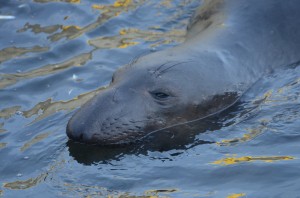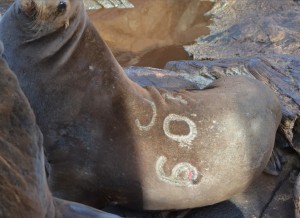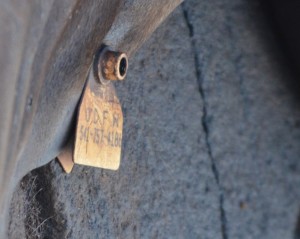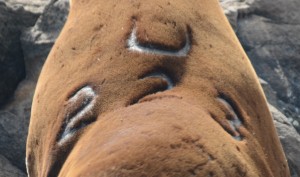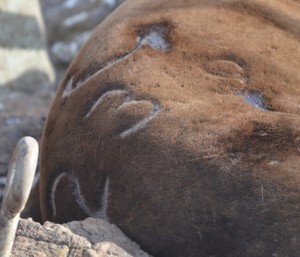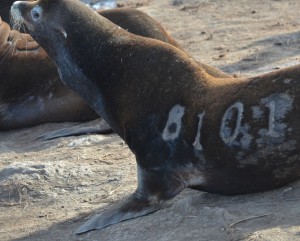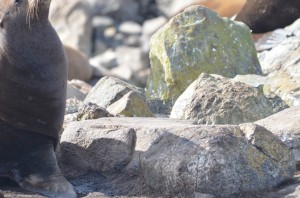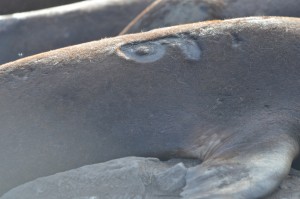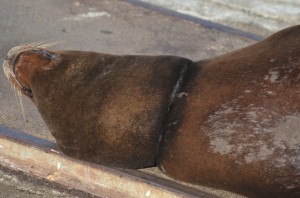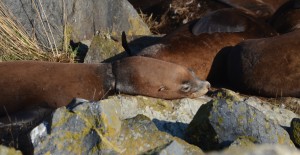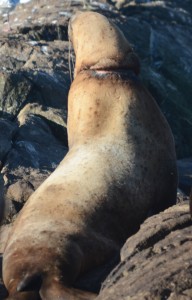The day started clear with clouds distant, to the east. A steady north by northeast wind of between 5 and 10 knots seemed to gradually bring the clouds around but Race Rocks remained in the donut hole as it often does, with sun dominating until late afternoon. The barometer is holding steady, if averaged over the last two days at ~ 1014 hPA, but the tendency now, is falling again, at the end of the day. There was no colour for sunset as the clouds built and the forecast calls for showers for the next few days, with easterly winds turning to westerly and fog patches dissipating near noon tomorrow.
It was a quiet day on the whale-watching front with only four visits to Race Rocks Ecological Reserve by commercial operators. There was an equal number of “pleasure” craft but they were not all as well behaved, with one of the Pedder Bay Marina rentals fishing in reserve. The marina is now able to track their rentals using GPS. They are really good about contacting their renters, when called and persuading them to move out of the Rockfish Conservation Area which is closed to sports fishing, for finfish in the Ecological Reserve.
There were repeated explosions across the way. A good ending for explosives I suppose, if you consider the alternatives. It seems to make the sea lions jittery and by that I mean more likely to stampede and go into the water. The Stellers seem more sensitive to disturbance in general.
Ecologically, the sea lion moult continues, elephant seals are trying to get up onto Great Race but there are a lot of sea lions in the way. Northern Elephant Seal # 5850 was back again this morning but didn’t make it up the ramp due to sea lion congestion. Later I saw him doing the ‘wave’ up the rocks in front of the Science House. Another individual seal joined the sea lion mosh pit east of the Eco-guardian’s House and others still hold their own on the top of Middle Rocks completely surrounded and outnumbered by Stellers Sea Lions but not bothered. The Sea Otter has been absent for a couple of days.
Bull kelp stipes are becoming more and more covered with epiphytes and their blades are loaded with spore patches increasing chances of a good settlement for the next generation. Cross jellies and barnacle moults continue to dominate the large zooplankton visible to the naked eye and the phytoplankton bloom has cleared which probably means either a crash or more likely lots of grazers like copepods and euphausids (aka krill). What ever cleared the phytoplankton certainly improved visibility into the water considerably. It is pretty cool to watch the big Steller’s Sea Lions ghosting through the kelp forest.
Black Oystercatchers are back, congregating on Great Race after an absence. More gulls and cormorants arrive in the area daily. There continues to be large, mixed-species feeding flocks including gulls and divers and multi-species gull feeding flocks associated with sea lion salmon kills. Salmon and halibut continue to swim past and around Race Rocks as evidence by the predators in the area, including human fishers talking about their catches on the radio. The Canada Geese are attempting a come back and it is difficult to keep them off as they just sit on the water waiting for the coast to clear. Every night the Killdeer return to Great Race as night falls.
Sea Lion brand and entanglement photography continues as do the daily chores to keep this place running sustainably. There were no visitors today.
- This patient elephant seal appears to be waiting for a chance to up the ramp.
- California Sea Lion # U601 from the Columbia River.
- California Sea Lion # U601 also has this Oregon tag on its fore flipper. I will try the number and report back.
- California Sea Lion #223
- California Sea Lion #U239
- California Sea Lion #8101
- California Sea Lion #5477
- Sea lions are damaging the ancient burial cairns by hauling out on them repeatedly.
- You can’t see the whole number but you sure can see the fur flying.
- California sea lion with a deadly plastic strap around its neck.
- Another necklaced California Sea Lion.
- Necklaced Steller’s Sea Lion.

